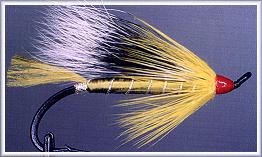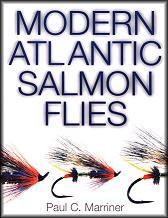Greased Line Fishing

By Paul Marriner
Only the sky retained its colour as sunset robbed the spruce
trees on the far bank of the Little Southwest Miramichi of their
individuality. A fishless day was fading away as I stood on a
shifting shingle bar in the middle of the river. Thirty yards
farther on the placid tailwaters of the pool became agitated by a
riffle. But I was more concerned with the swirling currents twenty
feet downstream and the submerged rock they betrayed. Staring at
the tranquil ease trapped between turbulent edges I felt a salmon's
presence. Previous down and across casts from upstream had pulled
the fly too quickly through the eddy so I cast straight out and
mended line vigorously several times to bring the fly as slowly as
possible into and out of the lie. On the second cast the size 6
Cosseboom took hold. The salmon was lost, but the lesson of its
transient capture by the greased line method wasn't forgotten.

Today, 'greased line', identifies an angling technique. But
this wasn't always true. During the early development of dry fly
tactics for trout, practitioners kept fly and line floating by
false casting to shed excess moisture. Someone soon realized that
applying water repellent substances to the line would keep it up,
hence - 'greased line.' Now, in the waning years of the nineteenth
century, the essential tool was available for anglers like Percy
Laming, one of the great British salmon fishers, to develop methods
for catching salmon during summer conditions on a floating
line/small fly.
Regardless, the term 'greased line fishing' is now associated
with the style developed by A.H.E. Wood early in this century. For
some thirty years his salmon fishing was largely confined to
Cairnton on the Aberdeenshire Dee in the west of Scotland -
although the genesis of the method was a chance discovery while
angling in Ireland. More accurately, rediscovery, as the catalyst
was catching several salmon by 'dibbling' a White Moth trout fly
over their heads and then giving line on the take. This technique
was centuries old but Wood was stimulated to modify and expand its
application.
Wood wrote sparingly, leaving it largely to others to
interpret his methods for popular consumption. Crawford Little, in
The Great Salmon Beats, summed up the unfortunate result with, "And
yet, what a host of misinterpretations it has been subjected to,
time after time after time." However, Wood's words can be found. He
was interviewed for the 1926 anthology, Fisherman's Pie, edited by
W.A. Hunter, approved notes on the method for Hardy's 1926
catalogue, wrote a chapter for The Lonsdale Library volume, Salmon
Fishing, issued in 1935, and left a great deal of correspondence.
But these fragments would not become the bible. Particularly for
post war anglers, the definitive text is Greased Line Fishing by
Jock Scott (a pseudonym for Donald Rudd), first published circa
1936. Surprisingly, a modern edition from Frank Amato Publications
is still in print.
Let's break from the gate by quoting from the latter, "The
basic idea is to use the line as a float for, and controlling agent
of, the fly; to suspend the fly just beneath the surface of the
water, and to control its path in such a way that it swims
diagonally down and across the stream, entirely free from the
slightest pull on the line." More than anything else, it's those
last nine words that have caused all the trouble. What's worse,
they have frequently been condensed to read, 'without drag'. The
phrase is nonsense. A fly swimming without pull from the line is
heading downstream with the current and will shortly, how shortly
depending on its weight, sink to the bottom. It must act under the
pull of the line if it's to move across stream. A closer reading of
what Wood says later almost clarifies the situation. He seemed to
be saying that you must keep the line upstream of the fly.
Unfortunately there are so many contradictory statements in his
correspondence that you wonder if he ever really did have a firm
grip on what the fly was doing.
Why did Wood want to cast across stream with a floating line?
Speculation is that he didn't like wading and wanted to use shorter
than normal (at that time) single handed rods. A.J. Barry, a
personal friend and correspondent, wrote in an appendix to The
Floating Line for Salmon and Sea Trout by Anthony Crossley, "You
will notice the reason why he never fished with a double-handed
rod, which was simply that he was unable to throw any sort of line
with one . . ." So, to cover the water from his bank and apply the
Irish lesson of keeping the fly near the surface, the solution was
virtually ordained.
Several modern writers have suggested that Wood wasn't
advocating casts directly across or upstream but simply more
upstream then currently popular. Although substantiated by
identical drawings in Salmon Fishing and Greased Line
Fishing, this theory is contradicted by his words. In
Fisherman's Pie he says,
". . . but my fly is very often floating or just awash, especially
during the first portion of the cast. If the water is suitable I
cast across and slightly up-stream, leaving slack line and letting
the fly drift down until the line begins to tighten; during most of
this time the fly will be floating and I often get fish at that
part of the cast. When the line tightens the fly will go under
water, but as the line and part of the cast are still floating, the
fly is only just under the water." And the Hardy's catalogue even
specifies an angle of 25 degrees upstream. Many of us have adopted
this approach to fishing Bombers and Buck Bugs for salmon and
steelhead or soft hackled wet flies for trout.
Before continuing with Wood's methods it's worthwhile to fill
in a little of the background against which they were developed (I
apologize in advance for the generalizations necessary to keep the
commentary flowing). Atlantic salmon fishing in Britain is largely
a Scottish affair. Early in the century the best runs were in late
winter or early spring and the icy waters dictated a large and
deeply fished fly. This suited the braided silk lines (which sank)
of the period. Once the water warmed and levels dropped, the salmon
rejected these tactics and so many beats were abandoned or leased
for much less until the fall run appeared. Persistent summertime
anglers offered sacrifices of worms and prawns.
Wood received considerable attention because he offered a
successful way to dispense with bait (and co-incidently increase
the value of summer leases). But his was not the only path to a
better life. Alexander Grant, a formidable angler, cast the
equivalent of a modern intermediate line (heavily oiled silk)
tremendous distances (120 to 140 ft.) at a shallow downstream
angle. This presentation fished small flies at a uniform speed and
close to the surface. Another celebrated salmon fisher, Ernest
Crosfield, threw an undressed silk line across stream and stripped
the fly in quickly to keep it near the surface. Finally, Percy
Laming, developed floating line techniques, much like those
detailed in Trey Combs' book on steelhead, to effectively deal with
all types of water.
Back to Wood's methods. To cast across or up stream and then
control the fly's speed (read, slow down, in most circumstances),
it's necessary to reposition the belly of the line, perhaps several
times, during the swing. Wood called this mending. Some say he
invented this technique, but they're wrong. Major John P. Traherne,
in Fishing (1885), wrote, "There is a way of taking the belly out
of a line, which was taught me by an old fisherman when fishing the
Kirkcudbrightshire Dee in my younger days. ... It was Jemmie that
pointed out to me the evil of allowing a belly to remain in my
line, and who taught me how to rectify it." There follows a diagram
and description of what is unmistakably mending. Of course, because
Traherne used sunk lines, only one mend is shown. To be fair, Wood
may have been the first to employ multiple mends with a floating
line. Regardless, hundreds of newly enlightened salmon fishers
flocked to Wood's home to watch the master roll thirty or more feet
of line up stream.
To contribute to the controlled movement of the fly, Wood
suggested that the caster lead the line slightly with the rod. This
adds to the length of down stream float and slows the fly's overall
progress. Ostensibly, the fly should pass somewhat broadside to the
fish. In Wood's words, "Perhaps the chief point is that you can
control the angle the fly swims in the water. I prefer the fly to
be at an angle of, say, 60 degrees." This is a touch rich. The
angle of the fly is subject to the currents unless leading very
strongly.
A lightly dressed fly was also an integral part of the system
but Wood was certainly no pattern junky. Blue Charms, Silver Blues
and March Browns sparsely tied in a wide range of sizes were
sufficient. He even experimented successfully with undressed
painted hooks.
Wood believed in feeding slack to a salmon that has taken the
fly. He wanted the current to pull the fly into the corner of a
salmon's jaw and then he would tighten. Over the years he modified
his views on how the slack should be given, sometimes suggesting a
loop of line, sometimes maintaining a high rod position for the
shock absorber affect. This hooking problem seemed to perplex most
of the thinking anglers of the period and is still the subject of
controversy today. About the only point of general agreement is
that striking immediately upon seeing the rise (except for the case
of dead drifting dry flies) is likely to lead to considerable
frustration. [1999 Note: my views on this have changed with
additional experience with the riffle hitch; salmon taking a riffle
hitched fly should be struck quickly upon seeing the rise, likely
because the angle between the fly and leader doesn't allow the fly
to be drawn into the scissors.]
Wood's final dictum was not to fish with the greased line
unless the air is warmer than the water. This equates to the homily
that time spent on the river before the morning mist lifts is
wasted. I suspect this has more to do with the angler's desire for
a late breakfast than salmon behaviour.

What role is the greased line method to be assigned in the
modern salmon and steelhead angler's arsenal, particularly in North
America? It's certainly useful in subduing unruly currents by
putting control of the fly's speed back in your hands.
Skillful use depends on your ability to mend delicately, especially substantial
lengths of line; a facility which can only be acquired through
practice.
Still, in my opinion, it's when we are fully exploiting
the dry fly/damp fly characteristics of Bombers and Buck Bugs that
we owe the greatest debt to the ideas of A.H.E. Wood. ~ Paul Marriner
|





